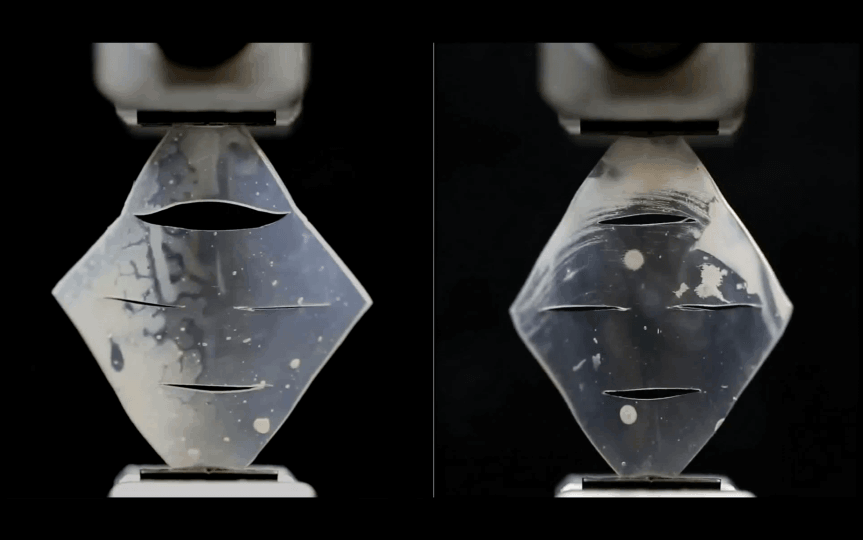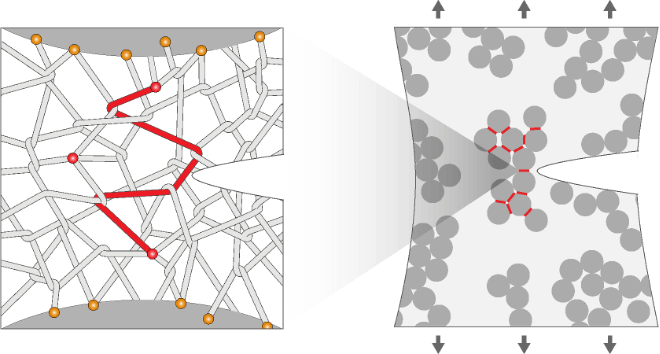News All News
December 15th, 2023
Rubber that doesn’t grow cracks when stretched many times
Multi-scale approach improves the fatigue threshold of particle-reinforced rubber
By Leah Burrows

SEAS researchers have developed a multiscale approach that allows particle-reinforced rubber to bear high loads and resist crack growth over repeated use. Above, cracks grow in the left sample while the cracks in the right sample, made from the multiscale material, remain intact after 350,000 cycles. (Credit: Suo Group/Harvard SEAS)
Researchers from the Harvard John A. Paulson School of Engineering and Applied Sciences (SEAS) have increased the fatigue threshold of particle-reinforced rubber, developing a new, multiscale approach that allows the material to bear high loads and resist crack growth over repeated use. This approach could not only increase the longevity of rubber products such as tires but also reduce the amount of pollution from rubber particles shed during use.
The research is published in Nature.
Naturally occurring rubber latex is soft and stretchy. For a range of applications, including tires, hoses, and dampeners, rubbers are reinforced by rigid particles, such as carbon black and silica. Since their introduction, these particles greatly improve the stiffness of rubbers but not their resistance to crack growth when the material is cyclically stretched, a measurement known as the fatigue threshold.
In fact, the fatigue threshold of particle-reinforced rubbers hasn’t improved much since it was first measured in the 1950s. This means that even with the improvements to tires that increase wear resistance and reduce fuel consumption, small cracks can shed large amounts of rubber particles into the environment, which cause air pollution for humans and accumulate into streams and rivers.
In previous research, a team led by Zhigang Suo, the Allen E. and Marilyn M. Puckett Professor of Mechanics and Materials at SEAS, markedly increased the fatigue threshold of rubbers by lengthening polymer chains and densifying entanglements. But how about particle-reinforced rubbers?
The team added silica particles to their highly entangled rubber, thinking the particles would increase stiffness but not affect fatigue threshold, as commonly reported in the literature. They were wrong.
“It was quite a surprise,” said Jason Steck, a former graduate student at SEAS and co-first author of the paper. “We did not expect adding particles would increase the fatigue threshold but we discovered that it increased by a factor of ten.”
Steck is now a Research Engineer at GE Aerospace.

SEAS researchers have developed a multiscale approach that allows particle-reinforced rubber to bear high loads and resist crack growth over repeated use. Above, cracks grow in the left sample while the cracks in the right sample, made from the multiscale material, remain intact after 350,000 cycles. (Credit: Suo Group/Harvard SEAS)
In the Harvard team’s material, the polymer chains are long and highly entangled, while the particles are clustered and covalently bonded to the polymer chains.
“As it turns out,” said Junsoo Kim, a former graduate student at SEAS and co-first author of the paper, “this material deconcentrates stress around a crack over two length scales: the scale of polymer chains, and the scale of particles. This combination stops the growth of a crack in the material.”
Kim is now an Assistant Professor of Mechanical Engineering at Northwestern University.
The team demonstrated their approach by cutting a crack in a piece of their material and then stretching it tens of thousands of times. In their experiments, the crack never grew.
“Our approach of multiscale stress deconcentration expands the space of material properties, opening doors to curtailing polymer pollution and building high-performance soft machines,” said Suo, senior author of the study.
“Traditional approaches to design new elastomeric materials missed these critical insights of using multiscale stress deconcentration to achieve high performance elastomeric materials for broad industrial uses.”
—Yakov Kutsovsky, an Expert in Residence at the Harvard Office of Technology Development
“Traditional approaches to design new elastomeric materials missed these critical insights of using multiscale stress deconcentration to achieve high performance elastomeric materials for broad industrial uses,” said Yakov Kutsovsky, an Expert in Residence at the Harvard Office of Technology Development and co-author of the paper. “Design principles developed and demonstrated in this work could be applicable across a wide range of industries, including high-volume applications such as tires and industrial rubber goods, as well as emerging applications such as wearable devices.”
Kutsovsky previously served as Chief Scientific Officer and Chief Technology Officer at Cabot Corporation for 15 years.
Two samples under cyclic loading. The cracks grow in the left sample while the cracks in the right sample, made from the multiscale material, remain intact after 350,000 cycles. (Credit: Suo Group/Harvard SEAS)
Harvard’s Office of Technology Development has protected the intellectual property associated with this project and is exploring commercialization opportunities.
The research was supported in part by the MRSEC grant DMR-2011754 and by the Air Force Office of Scientific Research under grant FA9550-20-1-0397.
Press contact
Leah Burrows
Harvard John A. Paulson School of Engineering and Applied Sciences (SEAS)
lburrows@seas.harvard.edu
Tags: SEAS, Materials, issued patents, licensing, climate
Press Contact: Kirsten Mabry | (617) 495-4157
